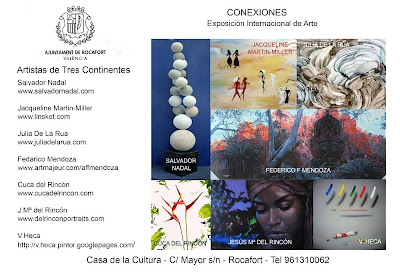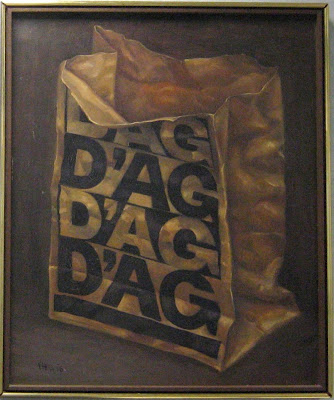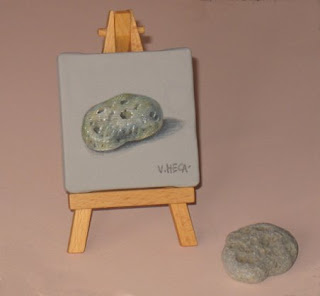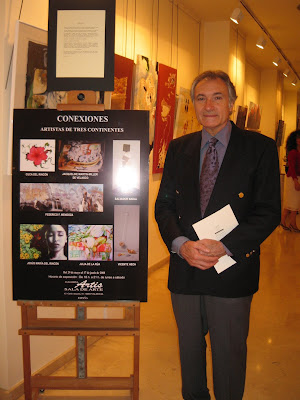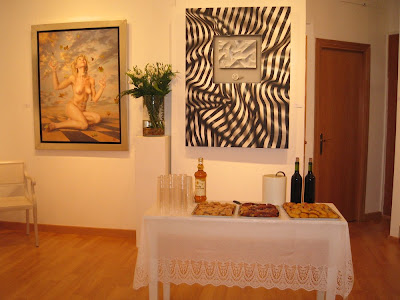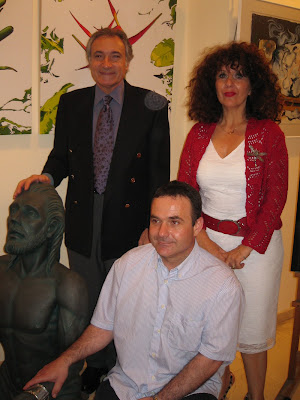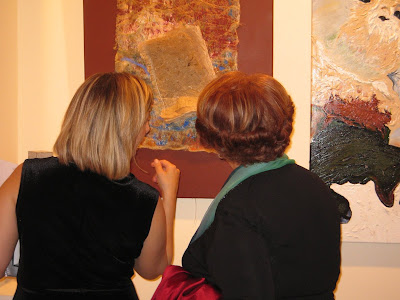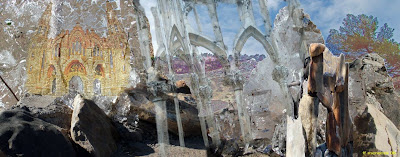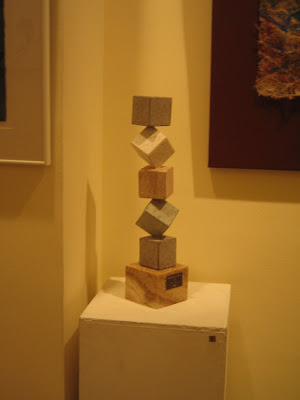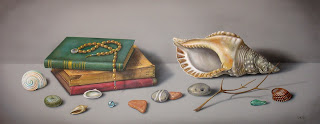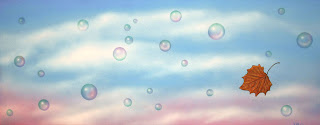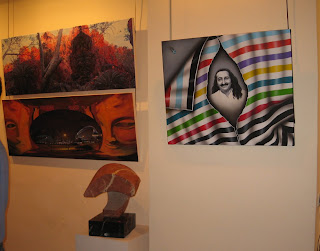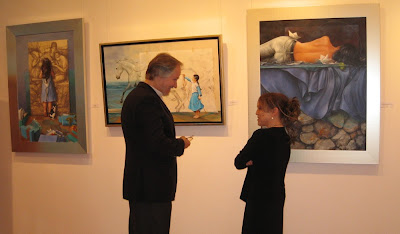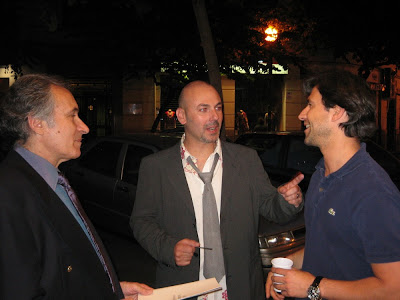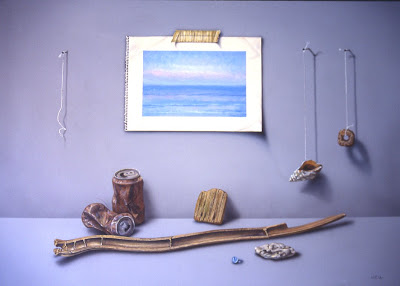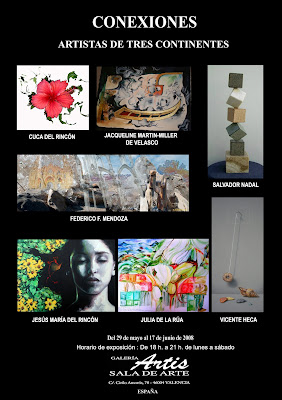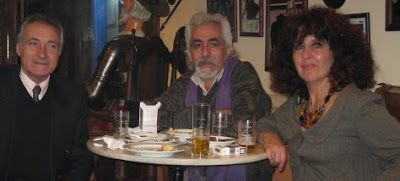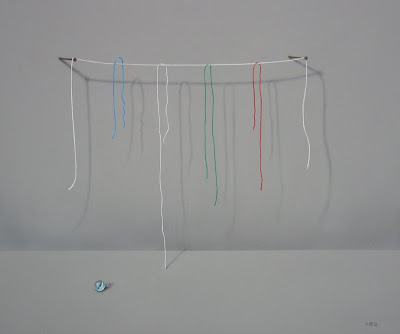by Kendra Crossen
Few things are more annoying than pontifications about art. I received a basic education in art, but I prefer to identify myself with those who don’t know anything about art but know what they like. I am interested in asking myself what I experience when I look at the paintings of Vicente Herrero Heca, what I appreciate about them, and what I might want to communicate to others about this.
Courses in art appreciation teach us what kinds of questions to ask when we view a painting—things like “Why do you think the artist chose this particular subject to paint?” “How has the artist applied the paint? ” “Is the composition balanced? “Where might the artist have stood while painting this picture?” These questions are not hard to answer (although in the case of Heca, that last question is a little weird—where did he stand while viewing a series of leaves floating below a patch of sky?). Is his composition balanced? Undoubtedly. How did he apply the paint? With mastery. Everyone admires skill (“It looks so real!”), and undoubtedly a work of art must demonstrate mastery of a skill; but is verisimilitude alone the primary virtue of art?
One of the questions we’re supposed to ask when criticizing artworks is what the creator set out to do and whether he or she accomplished it. But that doesn’t tell us whether we enjoy a painting and why. It may be enough to like a painting and not explain why we do, but for me it’s interesting to identify what is meaningful about it, how it conveys that meaning, and what else unfolds as I keep looking at it over time.
I found online a list of “Terry Barrett's Principles of Interpretation,” which I like. Here are a few of them:
- Artworks have "aboutness" and demand interpretation.
- Feelings are guides to interpretations.
- There can be different, competing, and contradictory interpretations of the same artwork.
- An artwork is not necessarily about what the artist wanted it to be about.
- The objects of interpretation are artworks, not artists.
- The meanings of an artwork may be different from its significance to the viewer.
(From Criticizing Art: Understanding the Contemporary by Terry Barrett. Mountain View, Calif.: Mayfield Publishing Co., 1994)
Of the points I omitted, I think these two are valuable, but I won’t discuss them in relation to Heca, as they can be easily analyzed by others: All art is in part about the world in which it emerged. All art is in part about other art.

DALÍ
HECA
I don’t think a painting, not a good one anyway, can be limited to what the artist intended. The work leaves the artist’s brush with a mind of its own, and even he may be surprised at what it does. We may not necessarily have to know what the intention was, though in some cases knowing it could significantly alter our perception. What about the Heca painting called Letter to the Future?
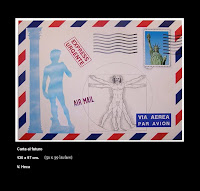
A group of familiar images is stripped down to colors and shapes, ones that are inextricably imbued with associations, not especially compatible ones. Is this a work of surrealistic incongruousness, or maybe a pop tribute to art and freedom? Does your response to it change if you find out that it was inspired by the campaign to legalize gay marriage in Spain? I wonder what other “meanings” this painting could have.
I imagine my reactions to art are similar to most other people’s. I want to be entertained or touched, to feel some fresh emotion, to be stimulated to reflect or remember, to be soothed or healed, to be uplifted and awakened or just simply pleased. I look for familiar shapes that I can identify with and also for ones that are competely strange to me, for a narrative, an entrée into a world where I can experience an alternative reality. I also want to know what I am experiencing and be able to describe it.
I am looking for a story to tell myself. The poet Muriel Rukeyser wrote, “The world is made up of stories, not of atoms.” Everyone has a child within, and the child demands stories.
I love to stare at a blank wall, not to make my thoughts go away but to paint them onto an empty screen so as to give them coherence. If there’s a Heca painting on the wall, that’s even better as a canvas for my projections. Some of his pictures flirt with the abstract, but I can never see them purely as colors and shapes (circles, squares, triangles, stripes), however visually interesting those might be. A cartoon in The New Yorker many years ago showed two ladies in hats examining a chaotically abstract painting in the museum and one says to the other, “I think I see a little bunny in there.” I smile at such naiveté but also understand it. The eye wants to look at something, preferably a body or anything relevant to human life, like a landscape, a division of the canvas into spaces that I can imagine my body in, an atmosphere of light and color and forms that put me in touch with the constant underground stream of energy and emotions and subtle fantasies that run beneath the surface of daily life.
Looking at some of these paintings is like taking a walk on the moon. I have stumbled into another world, one that may send me drifting aloft from the security of any surface. In many there is so little depth to the picture plane that I am forced to confront the image in an intense way, like someone whose nose has been pushed against a glass window. But soon I start to feel at home, recognizing my surroundings as an interior space of consciousness. This particular world is not initially familiar; I never before envisioned wide-eyed close-ups of wrinkled cloth or paper—torn, or tenuously mended, or with a marble floating in space peeping through a torn section … or a still life that materializes out of nowhere, with marbles or little pebbles or twigs casting shadows but with no discernible ground on which they rest, no identifiable source of illumination, so flat is the gray or pink background …yet sometimes there's a a patch of sky, a glimpse of space, a planet-like ball bobbing in a black void. I never imagined this myself, but now that I have seen these paintings, they have become part of my internal image bank, they exist within me as a visual reference point and have changed the way I look at things and think about them.
The artist’s gaze is a palpable presence on the canvas. It is not that I sense a man behind me causing the image to appear with a magic paintbrush, but I feel an aura of concentration and clarity. It gets transferred to me, not mechanically like a file from one computer to another, but as an energy of creativity radiating from one consciousness to another—or, as Heca believes, from the objects themselves. Because of the clarity of the artist’s vision, my vision clears up too and I see what he saw, making it my own.
What are these works about? Someone could say they sacralize the ordinary, elevate the humble to some kind of existential or visual holiness, to transform our perception of the mundane. But this is not quite the same as taking a snippet of so-called reality—a soup can, a Coke bottle, a paper bag—and giving it significance just by pretending it’s worthy of monumentalization, with or without irony. I don’t think there is irony in Heca’s work; it is sincere. Simple things seem worthy of attention in his paintings becase they are, that’s all.
To me these works are invitations to contemplation. They are conceptual, but that doesn’t mean they are cold or intellectual. The feeling in them is not always immediately apprehended; I need to absorb the image and let it work on me. There is sensuality in the billows and folds of the crumpled cloth. The marbles know that they are loved, and they give love back, in the form of light. Each one is a world, within which one can see swirling forms taking shape, to become something as yet unknown.
There’s a drama going on, an attempt to order reality, to take the torn or rumpled pieces of things subject to the wear and tear of time and perhaps of neglect or even violence, and to impart to them a calming order, or to sew their wounds, however tentatively, back together. And again, to allow them to tear, fall apart, scatter, or float. Maybe the folds are features of some earthy topography of the soul; the contours of a brain etched with neuronal pathways; or even body parts folded in on themselves, relaxed, or in motion, the limbs of a model posing or someone sprawled under the sheets.

The art historian James Elkins, in a fascinating book called The Object Stares Back, says that we inevitably see bodily forms, metaphors, or echoes in works of art. In an abstract painting, anything round can become an eye, and Heca’s marbles certainly stare back at us with catlike inscrutability. The artist has said that his marbles are symbols of the human being. If Elkins is right, then this is only natural and would be true even if Heca didn’t think of it. One could say they symbolize a human being isolated in his or her individual apartness from other beings. When the spheres are solid balls or bubbles, they are opaque or empty, but when they metamorphize (so to speak) into marbles, light and energy are transmitted outside the shell in the form of a shadow.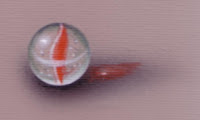
There’s often solitariness or aloneness in these paintings, not to say loneliness. I am reminded of a Sufi saying that speaks of a journey from the alone to the Alone—from the isolation of the single, separate individual to the divine Unity in which there is only One.

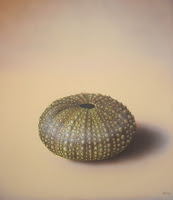
Objects may be placed in relationship to one another but without touching. Have they been ripped asunder, separated, or scattered? Each marble is a glass-enclosed tiny terrarium isolated within its own sphere. Inside, it evolves its own separate life forms. Yet it shares its marbleness with its companions. Or could the companions be evolving selves of the same marble-being … or a series of eggs with little embryos inside them? Are the marbles and rumpled fabric the descendants of still-life objects painted by Heca years ago?
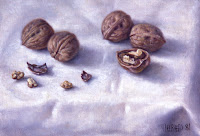
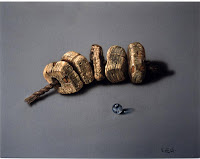


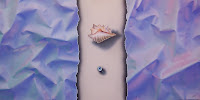
Over the years, the work has undergone a minimalist transformation, in which familiar, usually edible objects—comfort foods of the imagination—are distilled into concentrated images of the essence of time (the wrinkles, the weathered wood) and space (the objects in relation to their shadows, one another, and the picture plane). Although they are conceptual, these paintings are not just thoughts; they have an evocative “thingyness.” A treasure found on the shore or a weathered branch—entities once living, visibly formed by their history and still carrying life as a memorial to the passage of time. A rumpled bedsheet, perhaps, or is it gift wrap? Wrinkled brown paper. Something torn, revealing a surprise. Something torn being sewn together, healed.



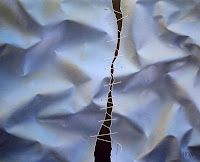
Sometimes the mending seems like a joke, with that flimsy thread barely holding crumpled paper together. Is it enough to keep body and soul together? But isn’t the paper after all rather rich-looking, earthy with hints of warm flesh tones or green highlights, and the striped material gleaming with a luxurious sheen? A snail slithers past a mended tear, like one of the silent shells from another painting suddenly come alive (see the painting "Snail" below).
I like the way the members of the marble series dialogue with one another. Sometimes the marbles are arranged as if the painter were compulsively bringing order to the world. At other times marbles escape or fall from the arrangement and go off on whimsical adventures of their own, abandoning the organizational life they endured in other paintings. They are naughty, entering places where they have no business being.



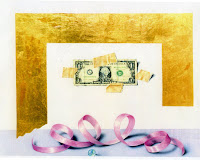
There’s that cheeky marble again, with a dollar bill “carelessly” taped on a surface, framed by gold leaf and a graceful bit of pink ribbon. Is it a social commentary making us aware of our crass attachment to money, or the world’s love of American values? (I hope not.) Are we receiving a gift? Whatever is happening, the marble stands by as an observing eye, perhaps mocking the whole thing.
The painting is visually interesting, and whether I can separate that experience from what I think when I see a dollar bill is a question. But maybe I don’t have to stop thinking about a dollar bill. It is, after all, a welcome sight, arousing a sense of power and impending gratification. The image reminds me of the currency framed by business owners to memorialize the first dollar they earned. Maybe it’s a lucky dollar. Paintings can be talismans.
Wherever an object appears in these paintings, even if its context is ambiguous (for example, when it’s hard to distinguish the earth from the sky), its inscrutable shadow accompanies it. This brings the marble or the twig into relationship, even if only to itself.
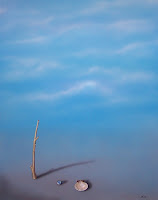
At times, objects come together and commune.
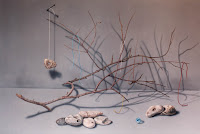
One cycles through the opposites of existence, between solitude and relationship, separation and union, infinite space and enclosure, flat color and nuanced textures, order and chaos.
But there’s really not much chaos. Things are deliberately placed, patiently composed, mindfully painted. Ultimately this is a world of order and restoration, with a mission of repairing the world, returning it to beauty, there to be contemplated in silence. Eventually each image produces in the viewer new moods and fantasies, like butterflies hatched and released into the ether. . . .










